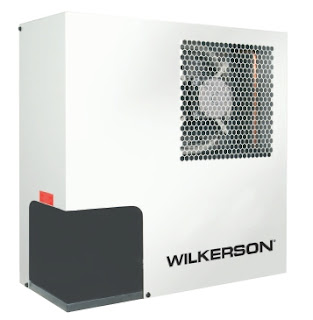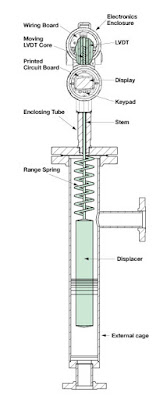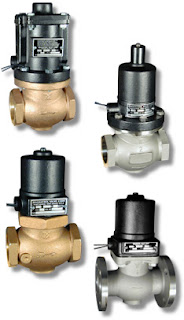 |
Refrigerated Dryer for Compressed Air
Wilkerson Corporation |
Compressed air, a common source of power in many industrial settings, functions best when treated in a number of ways to remove contaminants that can damage or impair downstream devices and equipment. One contaminant of concern is moisture.
When ambient air is compressed, its temperature increases, but also does the ratio of water per unit of air volume. This results in a compressed air supply with what may be an unacceptably high dew point. Dew point is the temperature at which air is saturated, and cooling air below its dew point will result in the formation of condensate (liquid water). As compressed air is consumed by usage equipment, the air pressure drops, along with the temperature. These condition changes, and others, can result in condensate formation in the compressed air system and connected equipment. This is generally considered a negative development, as the presence of excessive moisture can lead to line freezing, corrosion, excessive equipment wear, and malfunction.
There are a number of methods and technologies available to reduce the absolute moisture content of compressed air. Each has its own set of positive, as well as limiting, aspects that dictate the best way to apply the technology.
Refrigerated air dryers employ essentially the same principle used to dehumidify air in occupied spaces within commercial buildings and residences. The incoming compressed air is cooled through the use of a mechanical refrigeration system. Cooling the compressed air results in condensing a portion of it's moisture content. The chilled air is then used to pre-cool the incoming compressed air, boosting the cooling system effectiveness and increasing the temperature of the discharge air. This increase in the discharge air temperature is also helpful in preventing condensate formation on the downstream system piping.
The refrigerated air dryer is a single part of what should be a total approach to compressed air quality. Here is a schematic example.
 |
| A refrigerated dryer is one of several components that remove contaminants from compressed air systems |
More information and detail is provided in the document below. Share your compressed air system requirements and challenges with
application experts, combining your process experience and knowledge with their product application expertise to develop effective solutions.






